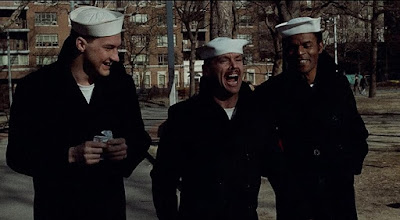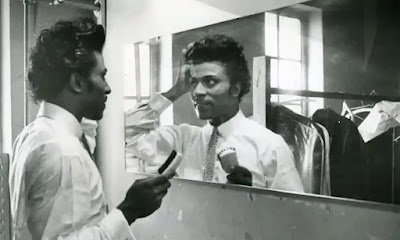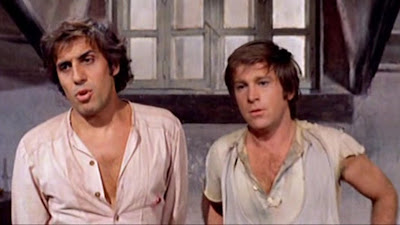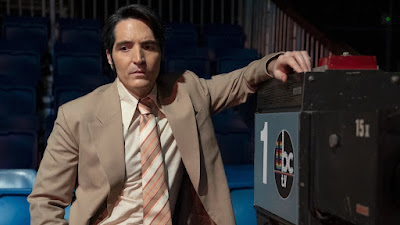
Physical Condition
Not a good start.
I have developed arthritis in my right knee and have a meniscal tear in the same place. This will be getting surgery soon. In the meantime I had to judge whether to walk into town (from close by) or take a tram which changed my leaving time. None of the venues takes long when I'm walking freely but with a cane and the variation in pain levels I had to do some quick rethinking for most sessions. Also, while I happily exchanged standby sessions for ones with fewer folk, I couldn't face adding sessions outside of MIFF Play. I also avoided multiple screenings on single days. Getting to a single one was already turning into planning. Going to a second in the same day was out of the question.
This aside, I was determined to enjoy everything I could about MIFF which is also my midyear holiday. Enjoy it, I did with some brilliant cinema experiences, good movies in lovely venues. A few things that have changed in the past few years annoy me. Even if they are the result of unavoidable cutbacks or contracts etc. they annoy me. I'll get to all of them below. Otherwise, one of the most fun fests for awhile.
The Program
One of the first things I noticed was how slim the horror section, Night Shift, has become. On the other hand the selection seemed a lot less shoehorned into the genre. Titles like Tiger Stripes and Suspiria didn't get into it, along with other adjacent films. Sorcery might easily have been classified as horror in an earlier festival. Eight titles. That's less than half of the average Night Shift of previous years.
This is the first section I look in as it's my kid of genre. So, looking beyond the sparser numbers to the quality, it pleased me well enough.
Aside from this, there was a good range of Australian features I actually wanted to see, some that looked enticingly beyond classification, and a number of film makers who I'll always try out. I didn't get to everything but the ones I did made for a solid experience.
Passes
For almost two decades, I would buy a mini-pass. This got me a plain ten sessions any time I wanted outside of the opening and closing. If I could find three more on weekdays before 6 p.m. I could add those. This changed my behaviour from any year previous. I would take at least one week off work and pepper it with daytime sessions and leave the evening only ones for the second week. This got me discovering the joys of morning sessions. They were never sold out and happened in venues I loved like The Forum or The Regent. When my leave for this extended first to a full fortnight and then a week after to decompress the MIFF holiday became better than any travel jaunt I'd been on.
From last year this changed to the share-pass which was pretty good. You could add other people to the same session, let them go by themselves and you got twelve sessions right off the bat without the time of day and day of week limitations of the mini-pass. So, I lose one but gain more freedom to chose. Also, as I could choose from most of the fare on any day, I managed to avoid the logistical awkwardness of multiple screenings on the same day. A positive upgrade.
MIFF Play
I like how this has carried over from 2020 but wish it could be run concurrently with the cinema program from the start. Also, the selection from the main program on Play this year is significantly smaller than on the previous three years. Nevertheless, that is how I was able to see the impressive Stone Turtle.
One gripe. Play needs either a computer to watch it on which is not ideal or a Chromecast. My home tv has a built in Chromecast so the operation is smooth but not every tv features this. Also, if you want to get subtitles from one of these films (a very high likelihood at MIFF) you have to wait until the feature is playing before opening settings, finding the subtitles option and setting it there. There is no auto setting on the app. Until you find this out (it isn't part of any instruction on the app or the website) you might think you've just wasted your money on a movie you can't watch properly.
MOVIES
High
Late Night with the Devil - maintains a delicate balance between satirical comedy and moments of credible horror.
Squaring the Circle (the Story of Hipgnosis) - interesting story and satisfying guided tour through the work of the monarchs of image creation for a decade, supported by interviews with the artists that benefitted and, poignantly with Peter Saville as the receiver of the baton as the culture changed. Astute.
birth/rebirth - pungent sci-horror scenario reminds us of both Cronenbergs while finding its own clear voice. The opposite of the kind of mainstream colour by numbers of It Lives Inside (see below)
Sorcery - sombre allegory of colonisation and culture clash from Chile sticks to its guns, impressing with heavy restraint on the flash.
Walk Up - new Hong Sang-soo. No notes.
Mid
Stone Turtle - like Groundhog Day with murder instead of jokes, this repeated sequence of action and revenge veers toward folk horror but also keeps its eye on the gravity of the crimes it depicts. Probably unclassifiable but that's a good thing.
Cobweb - consistently amusing satire on film making and culture under South Korea's dictatorship era. Wanted more funny.
The Five Days - Dario Argento's political satire tried for strength but threw that away every time it fell into goofy slapstick routines that set the standard back to zero.
You Can Call Me Bill - iconic star of iconic series delivers homilies as his mortality approaches. Saved from abject self-indulence by Shatner's own frequent self-awareness but also by a wealth of humbling archive material and some deft image mixing. But I cam away with less than I'd expected.
Little Richard: I am Everything - a good comprehensive look at a source point of rock music that for the first time to this depth, explored the star's gayness and how that added another layer inconvenient to previous histories of this complex figure. Just wish it had been given a stronger audio mastering.
Autobiography - intense tale of interpersonal colonisation set against corruption and the entitlement of ex-military leaders. I felt I wanted more from it, though, really, it was all but completely effective. Borderline.
Low
It Lives Inside - big budget horror has returned to the lameness it had in the late '90s before Blair Witch disrupted it. It plays too nicely, fails to scare and defies recollection weeks after a viewing. There was a potentially powerful story there about cultural assimilation and monsters emerging from it but it went the easy route and flattened out.
Missed
Monolith, Godless: The Eastfield Exorcism, You'll Never Find Me, Bird Eater, Sleep, Perpetrator, Tiger Stripes, Mutiny in Heaven: The Birthday Party, The Maiden, Bad Behaviour, and Hello Dankness. Some of these already have cinema release dates. Others will be lost to time.
Website
My first problem was that I couldn't log in to my MIFF account as the password was rejected. I tried a reset and followed the link in the email but it wouldn't accept the new one either. I emailed the info address and even posted about it on the MIFF Facebook page. The next day I had a hunch and did the reset boogie once again, this time reading the whole email and using the temporary password they'd supplied. I reset that and it worked. Um... Then I got a very helpful email telling me they'd reset it again. I took that as a karmic penance and did as they said.
There are always teething problems with the MIFF website as it always seems to go live prematurely. This year had the bizarre effect of links from my wishlist leading to a page with the message Film Not Found. I could click it up from the program itself. It made me think it was mistakenly listed.
If you searched by day (handy when you want to spread everything evenly throughout the fortnight) you had to wade through screen after screen of multimedia events and installations before you got to the movies. This is due to the earlier start times but it was very difficult to filter out of the results when on a curious browse. If you filtered around them by excluding AMCI as a venue the program was blank. The mornings had been all but wiped out. That had been a major drawcard of earlier festivals for me. Gone now.
App
The app didn't automatically update the way it had but I get impatient with these things and just downloaded it from the Google Store as soon as I could. The good news is that it was completely issue free. The old speed scrolling through tickets and wishlists wasn't an issue. Updates to the bookings from exchanges took a simple refresh. Navigation gave the edge to the app over the website which shouldn't be the case but there you go. Getting a pass or expecting to buy more than say three tickets? Get the app (for Apple and Android).
Snax
Everyone's choc tops were fine 'n' dandy with the Kino winning out as they have their own prepared ones. This year was supposedly the debut of the vaunted Gelato Bar but none of the venues I went to had them. Then, finally, they were on sale at ACMI. By the time I crunched into it it had melted to an unimpressive slop. The Forum's bar was swamped by latecomers who all seem to need a barista quality coffee before they can deign to sit in the auditorium. If I saw them swarming around there as the screening time started I proved how much more noble I was by sacrificing my choctop and striding right in.
Look, staffing can be difficult at the best of times but there seemed to be no planning for higher demand times like evening screenings.
Vollies
MIFF depends on its volunteer staff and they have been pretty exemplary. Gone are the days of cranky8 rudeness from the mid-2000s and before when they were clearly roped into bad employment deals. When the crowd control gets to feel more of a goal than it should it leads back to management. It feels like someone went to a few crowd control seminars and hardened the line on the kind of smiling push that was happening at the exits. Fine, manage the flow but don't let it feel like replacing one load of cattle with the next.
Venues
The Forum
The Forum is both a comfort and a frustration. There were far fewer screenings there this year with no indication as to why. It's my favourite venue of the whole festival and now it's harder to see films there. The downstairs area, a beautiful huge and mystique heavy room of dim lights and whispered conversations, timelessly dark at any hour, has long been lost to some kind of corporate interest. The replacement was initially a bar no one had heard of in Swanston St and then moved for the past two years to a tatty corner of ACMI as red as the Campari they want you to buy. It's tiny and looks like 3 a.m. at a club at the wrong end of the '80s. When I went to after film drinks with friends we found other places.
Capitol and Kino
I didn't end up going to the Capitol once. Nor the Kino. Just didn't pick anything on at the first and think of the Kino as my marginal mainstream go-to outside of the festival.
ACMI
The refurbished ACMI was fine and dependable as a screening venue but as I was driving a walking stick I wanted to avoid stairs where I could. There were several occasions when I went ot he centre's last screening and the complicated system of lifts meant that I couldn't just get up in a lift and come back down the same way. Three times I had to negotiate steps. The situation with the front doors was similar. Getting through a revolving door with a cane can be nerve wracking so I chose the wheelchair designed auto doors beside that and got dirty looks from staff who either didn't see or care that I was walking with assistance. At one late nighter I asked the guy at the door about it and he said I wouldn't be able to avoid stairs and would have to go around Fed Square. He did suggest helping me if I could wait five minutes. I thanked him and declined. Well meant but really there was nothing he could have done to alleviate the issue. At my last screening the volunteers were getting very antsy about the audience leaving only through the lower exits. I asked one about the stairs beyond the exit door and was told, politely enough, that there were more stairs out that way then there were going up. That's like telling a vegetarian that the meal doesn't have much meat in it. ACMI, work on your access.
Hoyts
This is one of the best appointed cinema chain venues in the city and I never have a problem getting a good, comfortable seat. It used to feel like a cheat going to a big time mainstream place for the Festival but I'll choose it over my favourite antique cinemas if the session is selling fast. It's just a no catch option.
The Comedy Theatre
I did get close to the front for Cobweb at the Comedy but one of my legs decided to cause me pain and I had to keep adjusting my sitting position to alleviate it. This was not the fault of the venue but its chairs and their uncomfortable vintage were not helping. The film I saw there, Cobweb, is about two and a half hours long.
So...
The first thing I can say is that I'm grateful to have gone to it at all, considering how bad my injury could get. The last time I missed out on a MIFF was eleven years ago when I was on crutches. I now know I made the right decision about that, considering how ill-prepared the venues were for anything less serious than wheelchairs (though I really didn't see a lot of them). But I did it. I managed to see a lot of good movies that I might not have any other access to outside of the festival context and I'm richer for that.
It worries me that the event is shrinking, though, in venue availability and the fare itself. I found more titles than I was able to see but it's starting to feel like a set and forget event. There seems very little in the way of adventure or celebration of cinema (outside of the watch ad at a lot of the screenings). Poignantly, the inclusion of a 4k screening of Bela Tarr's Werckmeister Harmonies emphasises this. When it was programmed in 2001 there was a playful mystique to the presentation of it, a sense of a once in a lifetime event. We were being invited to witness a moment in cinema but the promo was kept simple. It seemed to have been prepared by someone who had been wowed by the film. There was nothing like that this year and there hasn't been.
The reduction of the Forum's availability takes a lot out of the holiday for me. I like to begin and end there, just as a personal tradition. But the eleven a.m. slots have gone and it's become a slightly less attractive venue. I have no idea what was done to stop it being the festival hub but that happened and now that's been reduced to something more like a disco waiting room. But there are still good things to see and Play is a welcome addition as a continued feature. And it's still my winter holiday, cane or no, and that's still something to look forward to.






















